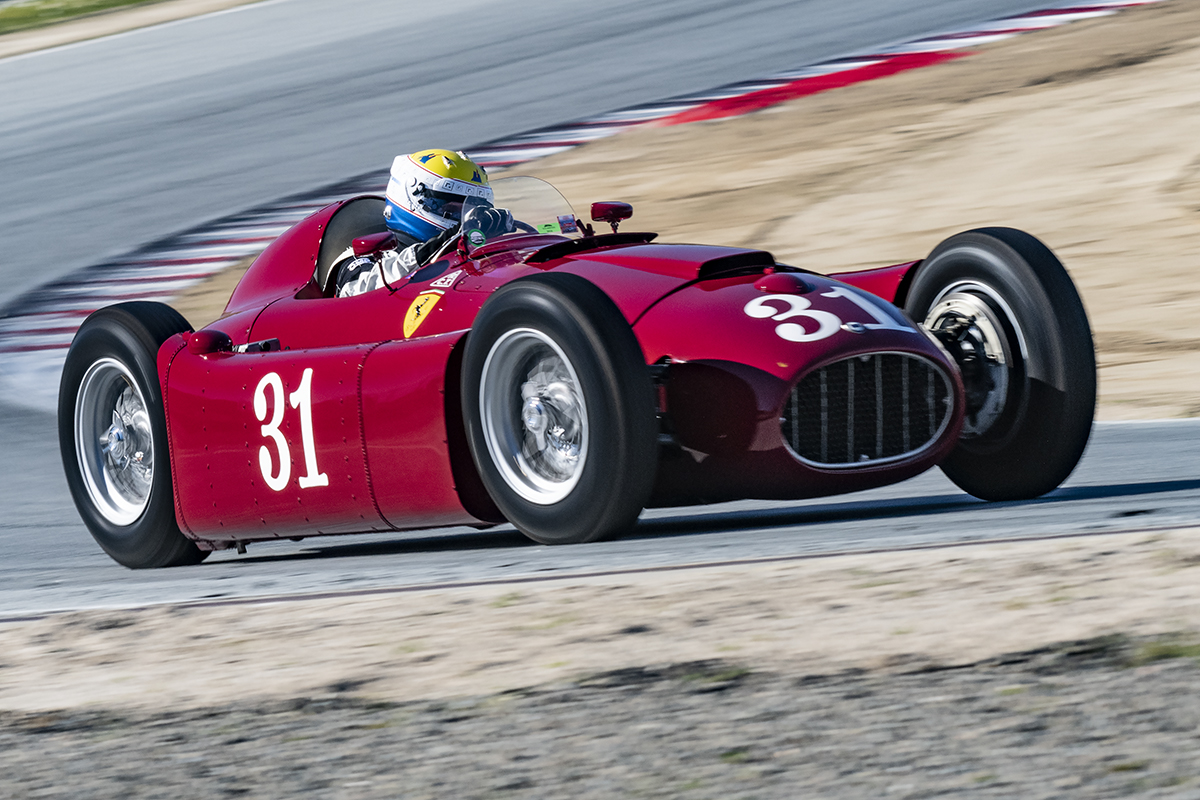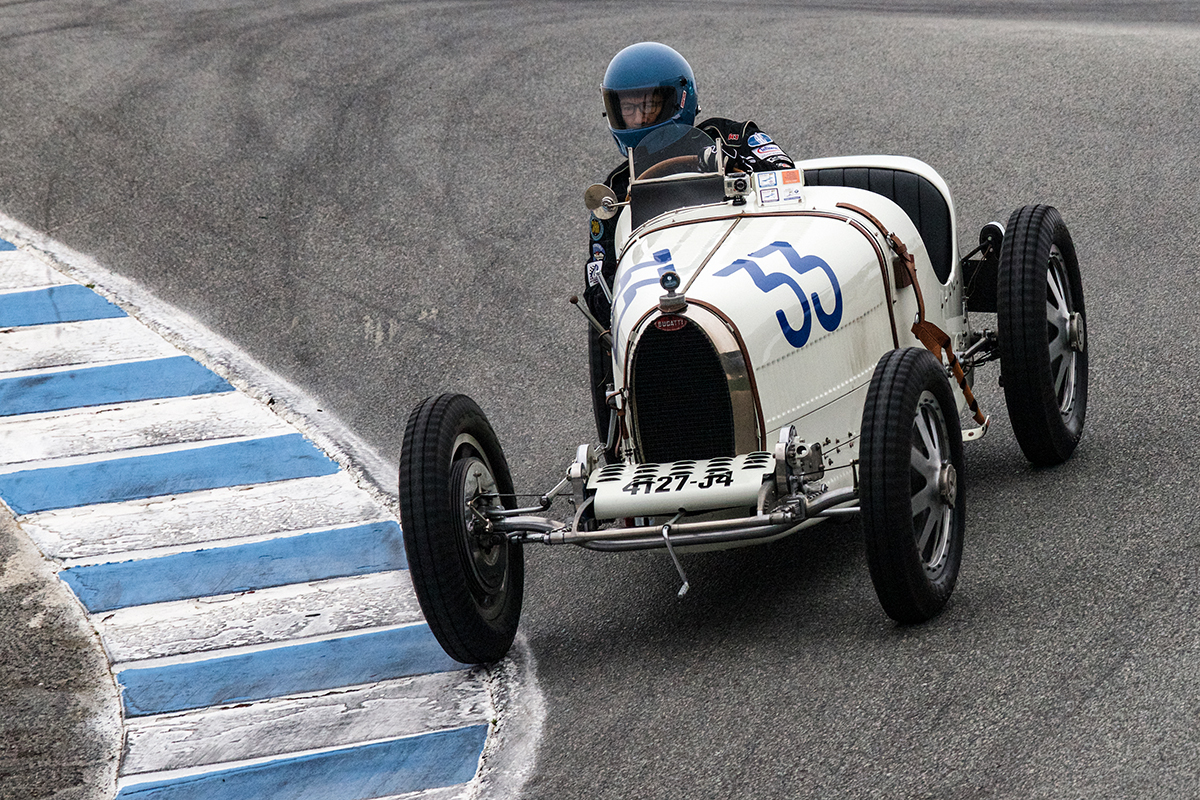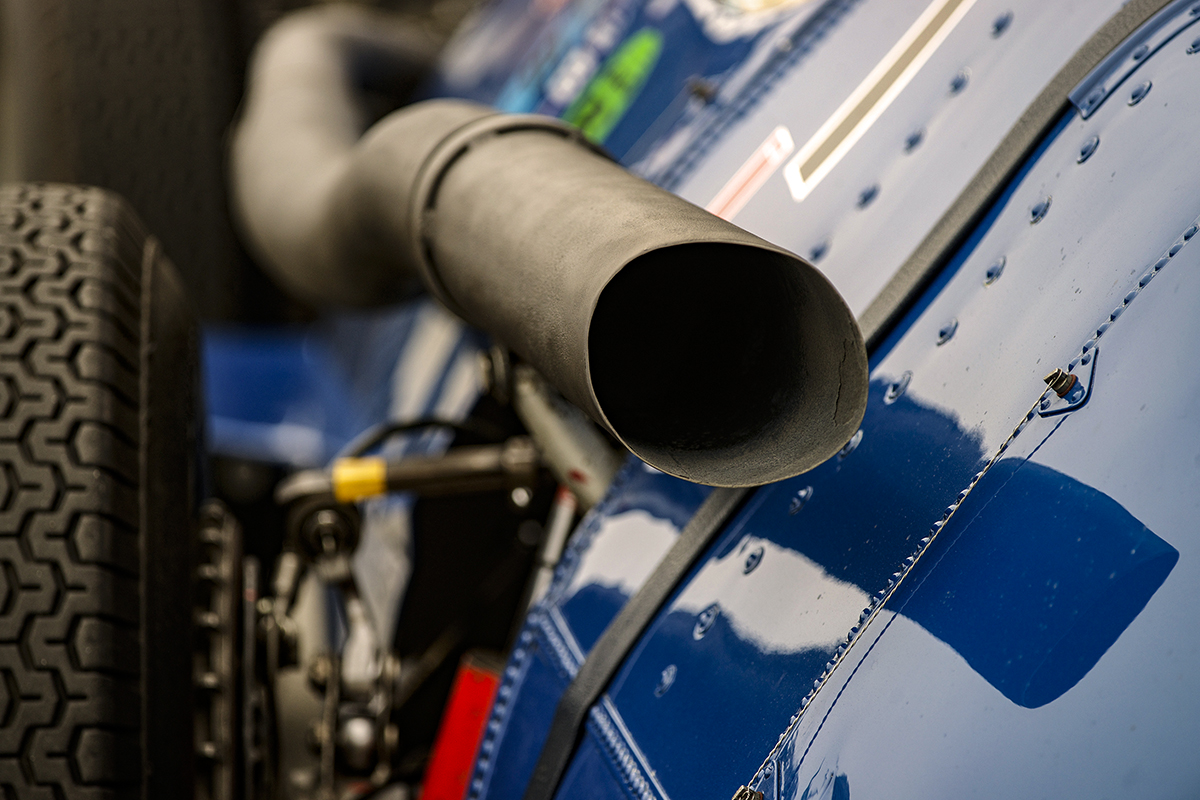
Charles Nearburg – 1954 Lancia D50A the 2019 HMSA Spring Club Event run at WeatherTech Raceway Laguna Seca. Nikon 200mm f/11 at 160 second for speed motion blur.
Interview by Brandes Elitch
Dennis Gray grew up in Turlock, California, back then a tiny ranching community of perhaps 10,000 people. In 1959, when Dennis was in 10th grade, his father gave him a Nikon camera. From that auspicious beginning, today Dennis is recognized as one a handful of the most important auto race photographers in the United States, with a body of work stretching over sixty years, and he is still shooting.
Just put this extraordinary event in perspective, the Nikon F single lens reflex camera was first sold in the U.S. in April, 1959. It was a breakthrough camera for many reasons, too many to go into here. The original price, with a 5 mm f2 lens, was $186, which would be equivalent to $1670 in today’s currency. This was quite a present for someone in tenth grade, so say nothing of the fact that a 35 mm SLR was pretty much an unknown quantity to most people at that time, kind of like something that fell from outer space.
While he was getting acquainted with interchangeable prisms and focusing screens, a depth of field preview button, mirror lock-up, bayonet mount, titanium-foil focal plane shutter, flash synchronization, and a fully removable back, his father was taking him to local SCCA races in Central California. Really, as a teenager, how lucky can you get? Now Dennis was learning about the Rule of Thirds and the Golden Spiral, and a lot more, and he hadn’t even graduated from high school yet.
This period was the Golden Age of American Sports Car Racing. After the privations of the 1930’s and 1940’s, Americans got into sports cars in a big way in the 1950’s. Anything and everything could and would show up at a local track, from a Crosley Hotshot to a Maserati. Many early SCCA events of the 1950s were held on disused Air Force bases, courtesy of General Curtis Le May, who was in charge of the Strategic Air Command. Tracks were not crowded and photographers had pretty much free range, particularly if they had a press pass, but even if they didn’t, there was a lot of action to capture, and Dennis was hooked. His father took him to the dirt track races at Merced County Fairgrounds, where the “racecars” were mostly prewar cut-down prewar Ford coupes, and then moved on to real sports car races at nearby Stockton airport. Someone said that movement breaks the stillness of the image, and creates a finite sense of time. I think that Dennis had this figured out pretty early in his life, when he was still an adolescent. He has been following that mantra for the last sixty years.
Dennis was a precocious lad, and when still in high school, he convinced the local paper to get him media credentials for a race at Laguna Seca! As he built his portfolio of work, he found himself in demand. By 1977, he was chosen Team Photographer for the George Dyer Racing Team. The next year he was Team Photographer for the Tom Spalding CanAm team. In 1980, he became the R.J. Reynolds Official Race Photographer for the 1979 and 1980 IMSA Series.
Of course, that was great fun, but you still have to make a living, don’t you? From 1976-2005, Dennis did corporate advertising photography for some pretty big names, such as BMW, Mercedes, Ford, Cadillac, Buick, Jaguar, and Honda, both cars and motorcycles, plus Pirelli and Goodyear tires. He has over one hundred television commercials to his credit. This means working with manufacturers, brands, businesses, promotional marketing, and commercial and corporate photography. This sounds pretty exotic, and I suppose it can be in some cases, but mostly it is just a lot of really hard, grueling work, getting assignments, travelling, unpacking, setting up, planning the shots, working with the clients, packing up again, going home, and then the really challenging work of editing and making a deadline.

Andrew Larson – 1935 Bugatti T37A Grand Prix in Group 1A at the 2016 Rolex Monterey Motorsports Reunion. Nikon f4 310mm f/11 at 1/1000 second. Here Gray is focusing on the driver’s eyes.
Lighting is a particular challenge. Light makes or breaks an image. And there is of course a story to tell, or there should be. Dennis for instance likes to focus on the eyes of the driver, if this is even possible in a high-speed environment. What Dennis has done is very different from what you might be accustomed to: fashion photography. In fashion photography, the subject is enhanced by exotic locations, beautiful models, avant-garde poses, and storybook locations. Often, it involves exotic cars. It uses human psychology to create a compelling desire to buy a product. It creates a brand story. Fashion images are sexy, trendy, hip, and vibrant. They have to be. They have to grab your attention.
Well, Dennis’s work grabs your attention, in no less compelling a manner. But, and this is the catch, I think you have to be knowledgeable about racecars to really appreciate it. This isn’t to say that a casual observer wouldn’t appreciate it, but it works better if you know about the racecar, the driver, the history of the marque, the history of the track, and such. For example, one of my favorites of his work is the Lancia D50. I am quite familiar with this car, having been a Lancia owner, written a book about Lancia and a column on Peter Giddings and this car for VeloceToday When I see this picture, I have a very emotional reaction. This is my way of saying that his work demands a knowledgeable audience, not a drive-by.
Now we get to the part you have been waiting for: how to review Dennis’s work and how you can purchase it. It turns out that he has, with Bill Wagenblatt, a website called Historic Motorprints. It was started back in 2015 to catalog prints at West Coast events, such as CSRG, MHSA, SCRAMP, SOVREN, and SVRA. Image galleries are posted by race group for each event, and there is even a gallery for each driver. They focus on the pre-grid atmosphere and the on-track action. The images posted are only a small part of the overall archive. They try to take three images of each driver/car for each event. Do you know how much work this is? Just go to www.historicmotorprints.com and you will get more information, and you can hit the Buy button.
I was lucky to meet with Dennis this month in Modesto. Here are some of the things I took away from our conversation.I asked about the difference between shooting film and digital. He said, “The biggest contrast is cost. The first time I came home from a race shooting with a motorized Nikon, I had 25 rolls of 36 exposure Kodachrome. After paying for processing, I was broke for a month!” The cost led me to develop my eye to look for peak action in an image, and to edit with the shutter. I carried this shutter edit habit over to my digital work. I never shoot multiple or burst exposures. This cuts down my editing time when I return to the hotel room.
I used to think that my Kodachrome images were sharp, with highlights and details in the shadows. Well, there is nothing like digital, raw, right out of the z7 Nikon. – just a few steps in PhotoShop to optimize the images, and they really sing!-The z7 Nikon has taken my images to a new high in sharpness and detail, across the range from deep shadow to bright highlights.
Another difference is post production speed. Each night, after shooting all day at an event, I send ten or fifteen images, cropped, captioned, and optimized (for print or web use) to my clients. I follow up in the next few days with another twenty or thirty images. In the old days, with film, I would not get the images back until Tuesday morning, and then have to edit them, so the client would not get the images (by Fedex even) until Friday, and that is if all went like clockwork. With digital, I can be creative – try new combinations of camera placement, shutter speed, and f stop for visual effects that would have been difficult with film. I can see instantly what the image looks like. The cost is nil!
With the mirrorless z7, I can see the finished image in the view finder, unlike earlier SLR cameras. This allows me, or even pushes me, to “expand my eye,” the goal of every photographer!” I asked Dennis about plagiarism, someone stealing his images. As a writer, I abhor plagiarism. This sort of thing seems rampant in the digital world, not that it was unheard of with prints or lithographs before that. He said that he did catch someone taking one of his prints and “embellishing” it by painting over it to create an “original work of art.” Dennis sued for $10,000 and won. Artists cannot just be artists; they have to be business people, and damn vigilant too.
After spending some time with Dennis, it is obvious that he is just as passionate as he ever was about motorsports photography. I have asked him to choose a few images, out of the tens of thousands that he has shot, to share with our readers. I think you will enjoy them.
Sports Car Digest
“For many years Dennis supplied historic racecar coverage for the website Sports Car Digest – The Sports, Racing and Vintage Car Journal. If you are reading this, I think we can assume that you are passionate about historic racecars. I want to alert you to the fact that recently Dennis has posted a three-part series there called “The Art of Vintage Race Car Photography.” May I suggest that this is mandatory reading for most VT subscribers, assuming you have a camera or smartphone. Not everyone thinks that they can be a writer, but everyone thinks that they are a good photographer!
This year Dennis has returned to Sports Car Digest and he is working closely with the new ownership to make it a premier site for current news on the vintage racing scene. This includes of course his own work, which is without parallel in this space as far as I can see. There is no charge for accessing the site so I recommend that you register there so you can get it pushed to you.
As for me, I need to get Dennis to autograph one of his prints for me, hopefully a Lancia.
Click here to see a Dennis Gray Gallery
Contact Dennis at:
Dennis Gray
415.269.5419
dennisgrayphotographer.com
historicmotorprints.com
To purchase a print, send Dennis a request and he will respond within a day.
Or, visit Sports Car Digest – The Sports, Racing and Vintage Car Journal


Always friendly, ubiquitous at vintage races, master photographer, good guy, car nut, alter ego to Bill Wagenblatt, Dennis faithfully swings by my pit to say hi at every event we attend.
Attaboy Dennis!
Dennis is a superlative race car photographer!
His work and personal life is Wicked Pissah.
It is a priviledge to know him.
Dennis is an incredible photographer and an incredible human being! I feel honored to know him.
Wonderful to see credit where credit is due. From Nikon glass to a glass of red, he’s our man!
A great eye and a good friend, and the same can be said of Bill.
Hello Bill, your photograhs are superb and beautifully crafted BUT I am plagued to say that a car like the Lancia D50 the likes of which are of such exotic wonder….when photographed with a driver in a modern racing suit and full face helmet leaves me utterly cold and dead. One day maybe these wonderful racecars can be seen with the driver in the garb of that time of original fame. Take that immortal shot of Fangio wrestling his 250F [ I think…..correct me if I am wrong ] bare arms, no seat belt and a rudimentary safety helmet. That is the standard……yes I know, the insurance needed to drive at good racing speeds in todays world would be out of the question. Pity.
Love to hear how it all started! To think that you got your start at such a young age and with a brand new Nikon during the golden age of motorsport -Incredible! Your work is superb and I am happy to work alongside you at events